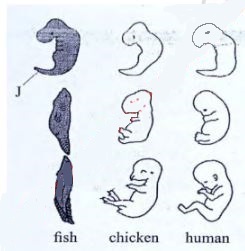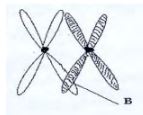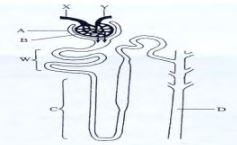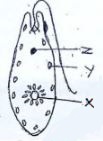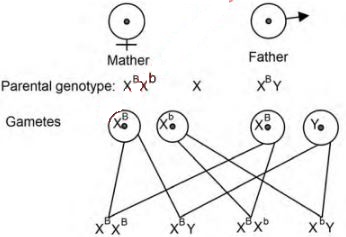BIOLOGY
Instructions to candidates
- Answer all the questions in the spaces provided.

Questions
- Identify the respiratory surfaces used by the following organisms.
- Locust (1mark)
- Paramecium (1mark)
- Name the causative agent of Tuberculosis (1mark)
- Explain the biological significance of the following:
- The mammalian testis hanging outside the body. (1mark)
- Coiled nature of the epididymis. (1mark)
- Breeding season of amphibians coincides with long rainy season. (1mark)
- State two ways by which plants manage their solid wastes. (2mark)
- State the effect of movement of the diaphragm muscles during inhalation in mammals. (3marks)
- The following are text messages on a cellphone that represent gene mutation.
Intended message Actual message I I hate meat I ate meat II This is my team This is my mate - Identify the type of gene mutation represented in each case
I.__________________________________________________________ (1mark)
II.__________________________________________________________(1mark)
- Identify the type of gene mutation represented in each case
- Below are diagrams representing developmental stages of three different vertebrates.
- State the evidence of evolution illustrated by the vertebrates in the diagrams above. (1mark)
- Suggest why the structure labeled J has been retained throughout the evolution of fish. (2marks)
- An individual is of blood group B+
- Name the antigens in the individual’s blood group. (2marks)
- Give the reason why this individual cannot receive blood from a blood group A donor. (2marks)
- Colour blindness is a sex linked trait controlled by a recessive gene b. If a mother is a carrier and the father is normal, what is the probability that their son will be colour blind? Show your working. (4marks)
-
- Explain the two role of diffusion in human beings. (2marks)
- What is meant by each of the following terms?
- Crenated cell. (1mark)
- Flaccid cell. (1mark)
- The diagram below illustrates a growing pollen tube.
- Name the part labeled B. (1mark)
- Explain the role of the part labeled A. (2marks)
-
- State one function of each of the following parts of a mammalian eye:
- Eye lashes. (1mark)
- Lachrymal gland. (1mark)
- Give a reason why the image is not formed when the light is focused on the blind spot. (1mark)
- State one function of each of the following parts of a mammalian eye:
-
- Define the term field of view as used in microscopy. (1mark)
- State one functions of the body tube of a light microscope. (1marks)
- Define the term field of view as used in microscopy. (1mark)
- How is the human stomach adapted to:
- Protein digestion. (2marks)
- Churning. (2marks)
- The diagram below shows a phenomenon which occurs during cell division.
- Identify the stage of cell division in which this phenomenon occurs. (1mark)
- Explain the importance of the phenomenon taking place in the part labeled B on the diagram above. (2marks)
- A wild beast in maasai mara national park was found to be infested with a lot of ticks. State the trophic level occupied by the following organisms.
-
- Wild beast. (1mark)
- Ticks. (1mark)
- Sketch a pyramid of numbers to represent the above feeding retionship. (1mark)
-
-
- Define seed dormancy. (1mark)
- State two causes of seed dormancy. (2marks)
- Name the type of response exhibited by the following:
- A pollen tube growing towards the embryo sac. (1mark)
- A maggot moving from lit side of a box to the dark side. (1mark)
- The diagram below illustrates a mammalian bone.
-
- Identify the bone. (1mark)
- Name the region in the human body where the bone named above is found. (1mark)
- Name the type of joint formed by the bone at the proximal end. (1mark)
- What is the role of the inter-vertebral disc? (1mark)
-
- Name the hormone that sustain the larval stage in insects and the structure that produces it.
- Hormone.________________________________________________(1mark)
- Structure._________________________________________________(1mark)
- The diagram below represents a nephron from a mammalian kidney.
- Name the parts labeled B and C. (2marks)
B_________________________________________________________________
C_________________________________________________________________ - Name the component of blood present in part labeled B but absent in part labeled C. (1mark)
- State one substance that is reabsorbed at the part labeled W. (1mark)
- Name the parts labeled B and C. (2marks)
-
- What is glycolysis? (1mark)
- Where in the cell does it take place? (1mark)
- State how the following parts of the mammalian ear are adapted to their functions.
- cochlea. (2marks)
- Pinna. (2marks)
- Two students used identical microscopes separately. Student A observed 10 bacteria while student B saw 50 bacteria from the same slide. Suggest a reason for the difference in numbers. (1mark)
-
- what are fossils? (1mark)
- Name the type of placentation where:
- Placenta appears as one ridge on the ovary wall. (1mark)
- Placenta is at the center of the ovary with ovules on it and the dividing walls of the carpel disappear. (1mark)
-
- Name the cell organelle found in abundance in the white blood cell.(1mark)
- Give a reason for your answer in (a) above. (1mark)
- Name the cell organelle found in abundance in the white blood cell.(1mark)
-
- In which form do the following organism excrete their nitrogenous waste.
- Insects and birds________________________________________ _(1mark)
- fresh water amoeba______________________________________ (1mark)
- What advantage do the insects have by excreting the nitrogenous waste named in (i) above? (1mark)
- In which form do the following organism excrete their nitrogenous waste.
- Below is a diagram of Euglena gacilis.use it to answer questions that follow.
- Classify the organism into the following taxa.
- Kingdom_________________________________________________(1mark) (ii)
- Genus____________________________________________________(1mark)
- Name the structure labeled X. (1mark)
- How is the structure Y adapted to its function? (1mark)
- Classify the organism into the following taxa.

Marking Scheme
- Identify the respiratory surfaces used by the following organisms.
- Locust (1mark)
- Tracheoles
- Tracheoles
- Paramecium (1mark)
- Cell membrane
- Cell membrane
- Name the causative agent of Tuberculosis (1mark)
- Mycobacterium tuberculosis /Mycobacterium bovis
- Mycobacterium tuberculosis /Mycobacterium bovis
- Locust (1mark)
- Explain the biological significance of the following:
- The mammalian testis hanging outside the body. (1mark)
- Provide a cool environment/low temperature;that is condusive /good/suitable/required/favour (good quality) sperm production;
- Provide a cool environment/low temperature;that is condusive /good/suitable/required/favour (good quality) sperm production;
- Coiled nature of the epididymis. (1mark)
- increase surface area for sperm storage;
- increase surface area for sperm storage;
- Breeding season of amphibians coincides with long rainy season. (1mark)
- Sexual reproduction in frogs require water/aquatic medium;
- Sexual reproduction in frogs require water/aquatic medium;
- The mammalian testis hanging outside the body. (1mark)
- State two ways by which plants manage their solid wastes. (2mark)
- Peeling or bark
- Falling of leaves
- Falling fruits
- Secreting gums and resins
- State the effect of movement of the diaphragm muscles during inhalation in mammals. (3marks)
- Diaphragm muscles contract and it flattens;leading to increase in volume of the thoracic cavity;decreasing the pressure inside it;(forcing air in)
- Diaphragm muscles contract and it flattens;leading to increase in volume of the thoracic cavity;decreasing the pressure inside it;(forcing air in)
- The following are text messages on a cellphone that represent gene mutation.
- Identify the type of gene mutation represented in each case
- delition; (1mark)
- inversion; (1mark)
- Identify the type of gene mutation represented in each case
- Below are diagrams representing developmental stages of three different vertebrates.
- State the evidence of evolution illustrated by the vertebrates in the diagrams above. (1mark)
- Comparative embryology;
- Comparative embryology;
- Suggest why the structure labeled J has been retained throughout the evolution of fish. (2marks)
- Fish remained in the aquatic habitat/aqueous medium;hence well developed tail/fin for propulsion/movement;
- Fish remained in the aquatic habitat/aqueous medium;hence well developed tail/fin for propulsion/movement;
- State the evidence of evolution illustrated by the vertebrates in the diagrams above. (1mark)
- An individual is of blood group B positive.
- Name the antigens in the individual’s blood group. (2marks)
- Antigen B; - Antigen D/rhesus antigen/rhesus factor;
- Antigen B; - Antigen D/rhesus antigen/rhesus factor;
- Give the reason why the individual cannot receive blood from a blood group A donor. (2marks)
- Has antibody a in the blood plasma of the recipient and will correspond with antigen A in the donor’s blood ;hence there will be agglutination;
- Name the antigens in the individual’s blood group. (2marks)
- Colour blindness is a sex linked trait controlled by a recessive gene b. If a mother is a carrier and the father is normal, what is the probability that their son will be colour blind? Show your working. (4marks)
1/4/25%/0.25 -
- Explain the two role of diffusion in human beings. (2marks)
- Absorption of materials;e.g diffusion of digested food materials into blood stream.
- Gaseous exchange;e.g carbon iv oxide diffuses from the capillaries into the alveoli/oxygen diffuses from alveoli to capillaries;
- Excretion of nitrogenous wastes ;e.g urea diffuses out of the blood capillaries into the elination sites.
- What is meant by each of the following terms?
- Crenated cell. (1mark)
- A shrunk animal cell that has lost water by osmosis; acc. RBC
- A shrunk animal cell that has lost water by osmosis; acc. RBC
- Flaccid cell. (1mark)
- Flubby /shrunk plant cell that has lost water by osmosis; acc.epidermal cell.
- Flubby /shrunk plant cell that has lost water by osmosis; acc.epidermal cell.
- Crenated cell. (1mark)
- Explain the two role of diffusion in human beings. (2marks)
- The diagram below illustrates a growing pollen tube.
- Name the part labeled B. (1mark)
- Tube nucleus
- Tube nucleus
- Explain the role of the part labeled A. (2marks)
- One male nucleus fuses with the egg cell to form a zygote;the other male nucleus fuses with the polar nuclei to form the endosperm;
- One male nucleus fuses with the egg cell to form a zygote;the other male nucleus fuses with the polar nuclei to form the endosperm;
- Name the part labeled B. (1mark)
-
- State one function of each of the following parts of a mammalian eye:
- Eye lashes. (1mark)
- Trap foreign particles entering the eye; acc.emaples of foreign particles e.g dust/small insects
- Trap foreign particles entering the eye; acc.emaples of foreign particles e.g dust/small insects
- Lachrymal gland. (1mark)
- Production of tears;/produces a fluid /tears which washes foreign particles out of the eye/has antiseptic properties /kills pathogen/harmful micro organisms;
- Eye lashes. (1mark)
- Give a reason why the image is not formed when the light is focused on the blind spot. (1mark)
- Lacks both cones and rods ;(hence images are not perceived)
- Lacks both cones and rods ;(hence images are not perceived)
- State one function of each of the following parts of a mammalian eye:
-
- Define the term field of view as used in microscopy. (1mark)
- A circular area seen when forcusing /viewing through the eye-piece of a microscope;
- A circular area seen when forcusing /viewing through the eye-piece of a microscope;
- State one functions of the body tube of a light microscope. (1mark)
- Hold the revolving nosepiece/objective lenses in position;
- Hold the ocular/eye-piece lens in place;
- Define the term field of view as used in microscopy. (1mark)
- How is the human stomach adapted to:
- Protein digestion. (2marks)
- Has gastric gland;that secretes gastric juice; acc.content of gastric juice e.g hcl,pepsin,renin,mucus.
- Has gastric gland;that secretes gastric juice; acc.content of gastric juice e.g hcl,pepsin,renin,mucus.
- Churning. (2marks)
- Thick muscular walls;that contracts and relax;
- Thick muscular walls;that contracts and relax;
- Protein digestion. (2marks)
- The diagram below shows a phenomenon which occurs during cell division.
- Identify the stage of cell division in which this phenomenon occurs. (1mark)
- Prophase I; rej. Meiosis I
- Prophase I; rej. Meiosis I
- Explain the importance of the phenomenon taking place in the part labeled B on the diagram above. (2marks)
- Allow for exchange of important genetic materials;resulting into variation;
- Allow for exchange of important genetic materials;resulting into variation;
- Identify the stage of cell division in which this phenomenon occurs. (1mark)
- A wild beast in maasai mara national park was found to be infested with a lot of ticks. State the trophic level occupied by the following organisms.
-
- Wild beast. (1mark)
- Primary consumer;
- Primary consumer;
- Ticks. (1mark)
- Secondary consumer;
- Wild beast. (1mark)
- Sketch a pyramid of numbers to represent the above feeding retionship. (1mark)
-
-
- Define seed dormancy. (1mark)
- A condition /period of rest during which a viable seed performs its physiological process slowly and utilizes little food /cannot germinate even if all the environmental conditions /factors for germination are provided;
- A condition /period of rest during which a viable seed performs its physiological process slowly and utilizes little food /cannot germinate even if all the environmental conditions /factors for germination are provided;
- State two causes of seed dormancy. (2marks)
- Immature embryo/impermeable testa/unfavourable temperature/growth inhibitors/inadequate germination enzymes/inadequate light wavelength;
- Immature embryo/impermeable testa/unfavourable temperature/growth inhibitors/inadequate germination enzymes/inadequate light wavelength;
- Define seed dormancy. (1mark)
- Name the type of response exhibited by the following:
- A pollen tube growing towards the embryo sac. (1mark
- Positive chemotaxis;
- Positive chemotaxis;
- A maggot moving from lit side of a box to the dark side. (1mark)
- Negative phototaxis;
- Negative phototaxis;
- A pollen tube growing towards the embryo sac. (1mark
- The diagram below illustrates a mammalian bone.
-
- Identify the bone. (1mark)
- Femur;
- Femur;
- Name the region in the human body where the bone named above is found. (1mark)
- Upper hind limb; acc thigh
- Upper hind limb; acc thigh
- Name the type of joint formed by the bone at the proximal end. (1mark)
- Ball and socket joint;
- Ball and socket joint;
- What is the role of the inter-vertebral column? (1mark)
- Reduce friction(between vertebrae);
- absorb mechanical shock;
- allow flexibility of the vertebral column;
- Identify the bone. (1mark)
-
- Name the hormone that sustain the larval stage in insects and the structure that produces it.
- Hormone. Juvenile; (1mark)
- Structure.corpus allatum; (1mark)
- The diagram below represents a nephron from a mammalian kidney.
- Name the parts labeled B and C. (2marks)
- B glomerulus;
- C loop of henle;
- Name the component of blood present in part labeled B but absent in part labeled C. (1mark)
- Plasma protein; / blood cells (first one)
- Plasma protein; / blood cells (first one)
- State one substance that is reabsorbed at the part labeled W. (1mark)
- Glucose;vitamins;amino acids;hormones;watet; (fisrt one)
- Glucose;vitamins;amino acids;hormones;watet; (fisrt one)
- Name the parts labeled B and C. (2marks)
-
- What is glycolysis? (1mark)
- Breakdown of glucose into pyruvic acid;
- Breakdown of glucose into pyruvic acid;
- Where in the cell does it take place? (1mark)
- Cytoplasm;
- Cytoplasm;
- What is glycolysis? (1mark)
- State how the following parts of the mammalian ear adapted to their functions.
- cochlea. (2marks)
- Highly coiled;to increase surface area for attachment of sensory cells;or has systems of canals filled with endolymph and perilymph;to absorb mechanical sock
- Highly coiled;to increase surface area for attachment of sensory cells;or has systems of canals filled with endolymph and perilymph;to absorb mechanical sock
- Pinna. (2marks)
- Funnel shaped to enable it collect and direct sound waves into the external auditory meatus/auditory canal;
- Funnel shaped to enable it collect and direct sound waves into the external auditory meatus/auditory canal;
- cochlea. (2marks)
- Two students used identical microscopes separately. Student A observed 10 bacteria while student B saw 50 bacteria from the same slide. Suggest a reason for the difference in numbers. (1mark)
- A used objective lens with higher magnification power/widerfield of view while B used lower magnification power/wider field of view;
-
- what are fossils? (1mark)
- Past materials /remains of ancestral forms of organisms that were accidentally preserved in a naturally occurring material;
- Past materials /remains of ancestral forms of organisms that were accidentally preserved in a naturally occurring material;
- Name the type of placentation where:
- Placenta appears as one ridge on the ovary wall. (1mark)
- Marginal;
- Marginal;
- Placenta is at the center of the ovary with ovules on it and the dividing walls of the carpel disappear. (1mark)
- Free central
- Placenta appears as one ridge on the ovary wall. (1mark)
- what are fossils? (1mark)
-
- Name the cell organelle found in abundance in the white blood cell.(1mark)
- Lysosome; acc golgi bodies
- Lysosome; acc golgi bodies
- Give a reason for your answer in (a) above. (1mark)
- Lysosomes –contain lytic enzyme that destroy the pathogen;
- Golgi bodies-forms lysosomes which contain the lytic enzyme to destroy the pathogen;
- Name the cell organelle found in abundance in the white blood cell.(1mark)
-
- In which form do the following organism excrete their nitrogenous waste.
- Insects uric acid; (1mark)
- Birds uric acid; (1mark)
- What advantage do the insects have by excreting the nitrogenous waste named in (i) above? (1mark)
- Uric acid is less toxic and less water soluble hence its excretion consumes little water;thus water is consumed;
- Uric acid is less toxic and less water soluble hence its excretion consumes little water;thus water is consumed;
- In which form do the following organism excrete their nitrogenous waste.
- Below is a diagram of Euglena gacilis.use it to answer questions that follow.
- Classify the organism into the following taxa.
- Kingdom protoctista; (1mark)
- Genus Euglena; (1mark)
- Name the structure labeled X. (1mark)
- Contractile vacuole;
- Contractile vacuole;
- How is the structure Y adapted to its function? (1mark)
- Contain chlorophyll pigment that trap light energy for photosynthesis;
- Classify the organism into the following taxa.
Join our whatsapp group for latest updates
Tap Here to Download for 50/-
Get on WhatsApp for 50/-
Download Biology Paper 1 Questions and Answers - Maranda Mocks 2022 Exams.
Tap Here to Download for 50/-
Get on WhatsApp for 50/-
Why download?
- ✔ To read offline at any time.
- ✔ To Print at your convenience
- ✔ Share Easily with Friends / Students

